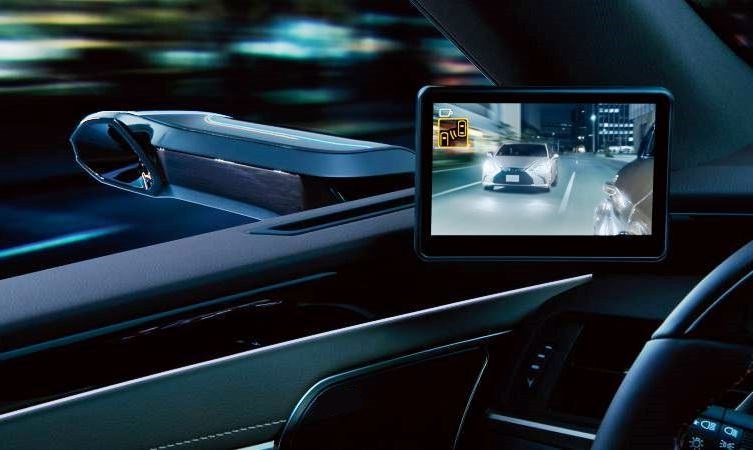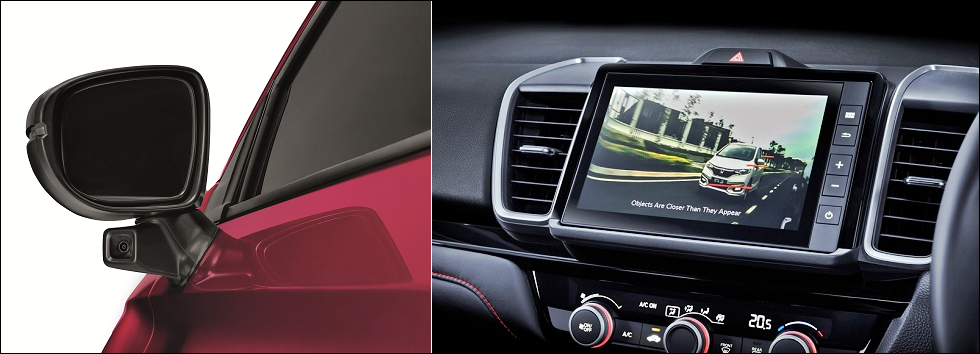Although the Virtual Exterior Mirrors in the latest Audi Q8 e-tron S Line 55 Quattro may seem like a recent innovation, the concept of using cameras instead of reflective surfaces for rearview door mirrors on cars has been around for a long time. It has been a popular feature in concept cars as a way to emphasise the ‘digital future’ and GM’s HyWire concept demonstrated such mirrors in use in 2002.
![GM HyWire EV [2002]](https://www.motaauto.com/wp-content/uploads/2023/09/GM-HyWire-EV-2002-1.jpg)
![GM HyWire EV [2002]](https://www.motaauto.com/wp-content/uploads/2023/09/GM-HyWire-EV-2002-2-e1695714866985.jpg)
But it would only be in 2018 that Lexus would be the first company to offer it in a production model. The ES300h was the first car in the world to have door mirrors which used cameras instead of the reflective surfaces that are still dominant.
![Lexus ES300h [2021]](https://www.motaauto.com/wp-content/uploads/2023/09/Lexus-ES300h-2021-2.jpg)
![Lexus ES300h [2021]](https://www.motaauto.com/wp-content/uploads/2023/09/Lexus-ES300h-2021-1-1.jpg)
The reason why the feature, though advanced, seems to not be offered widely and only in a few models is not just related to it being an expensive alternative for conventional mirrors. The concept of camera-based mirrors is still not allowed in many countries but the Malaysian Road Transport Department seems to be okay with it, hence allowing it for the Q8 e-tron.
![Honda e EV [2022]](https://www.motaauto.com/wp-content/uploads/2023/09/Honda-e-EV-2022.jpg)
Click here to know more about the Audi Q8 e-tron
Since authorities in various countries have still not approved it, the carmakers are probably not promoting it so much yet. This will mean that production of such mirrors will not grow rapidly in volume so soon for economies of scale to bring their costs down where they can be offered more widely.
![Genesis GV60 [2022]](https://www.motaauto.com/wp-content/uploads/2023/09/Genesis-GV60-2022.jpg)
Advantages over conventional mirrors
These high-tech mirrors have a number of advantages over traditional mirrors, with less wind resistance being one of them. This is why you will likely see them bring offered on future EVs which require the lowest possible wind resistance to improve range.
The reduced wind resistance comes from having a much smaller housing sticking out from the body. Traditional mirror housings are large and though optimised in shape, they still cause drag and turbulence. Anything that sticks out from the body surface affects the airflow. That’s why designers have even made door handles flush.
![Audi Q8 e-tron mirrors [2022]](https://www.motaauto.com/wp-content/uploads/2023/09/Audi-Q8-e-tron-mirrors-2022.jpg)
Better aerodynamics, extra range
According to Audi, the drag on the Q8 e-tron decreases from 0.28 with the conventional mirrors to 0.27 with the Virtual Exterior Mirrors. It seems like a small change but the carmaker says that this can increase the range by around 35 kms per battery charge. This gain, if achieved by reducing vehicle weight, would require an Audi e-tron to be half a metric ton lighter.

Bosch, which makes digital mirror systems for large commercial vehicles, says that they help to reduce fuel consumption by up to 2%, besides giving the driver a better view around the vehicle, especially in the area below the level of the cabin.
Making motoring safer
Using a camera offers many advantages from the field of view to the clarity in poor lighting conditions. If you have a rearview camera on your car, you will notice that even when it is dark, you can still have a clear and bright image on the screen. The same applies for the digital door mirrors which is certainly helpful for safer motoring.
Today’s conventional door mirrors are not cheap to replace as many now contain motors and other hardware for pushbutton convenience in adjusting and folding. The camera-based ones would be even more expensive as they are more sophisticated,


Variable view
Depending on the manufacturer, the system may also have a variable view. For example, when the driver uses the turn indicators, the coverage can be widened to provide a better view along the sides of the car where there are blind spots. This is something conventional mirrors cannot do and at best, some mirrors have dual view angles (half of the mirror gives a wider view).
On highways, the field of vision can be reduced so that the driver can better estimate speeds when driving fast as other vehicles then appear larger in the display.
The cameras constantly provide imagery in real-time which is digitally processed images. These then appear on small display panels (7-inch OLED 1280 x 1080 pixels in the case of the Q8 e-tron) on the door or the edge of the dashboard. The positioning slightly reduces the turning of the head and being near the mirrors also works well intuitively.
Honda LaneWatch
While the digital mirror concept like Audi’s Virtual Exterior Mirrors is in limited use, Honda has for many years offered a camera-based system as a blind spot monitor. There are still conventional mirrors but on one side (opposite to the driver), a small camera is mounted on the door mirror housing.
This small camera is activate whenever the driver uses the signals (or can also be manually activated), providing a view of the area along the side of the car. The image, which covers the blind spot, is shown on the centre display. Like the digital door mirrors, it also provides a clear and bright image even at night.

The LaneWatch system is an innovative approach to blind spot monitoring and it also reduces the amount of head-turning required. The driver only has to turn to look at the screen, which is less than turning to look at the door mirror.
Honda has been able to bring the cost of its LaneWatch system down so that it can be offered as standard in a wide range of Honda models sold in Malaysia today.
Digital interior mirrors
Also slowly making their appearance are digital rearview mirrors inside the car. Quite a number of the latest models have them though the owners might not be aware of their high-tech capability. In the latest Nissan LEAF EV, for example, the Intelligent Rearview Mirror is essentially a small LCD monitor. It displays imagery from a camera mounted at the back of the vehicle.

Besides the clear imagery of the situation behind, the digital rearview mirror also has the advantage of not being blocked by the heads or head restraints of rear occupants. And when desired (in the case of the LEAF), it is also possible to switch back to a conventional mirror to check on pets or little children behind.
Click here to know more about the Nissan LEAF
Just as you can install cameras for rearview displays during parking, there are also aftermarket rearview mirrors which display imagery from a camera so you can have the high-tech feature without buying one of the latest cars. However, you should be aware that when installing such aftermarket accessories, any modification of the vehicle’s wiring can affect the warranty.
![Audi Q8 e-tron [2022] Audi Q8 e-tron [2022]](https://www.motaauto.com/wp-content/uploads/2023/09/Audi-Q8-e-tron-2022-696x464.jpg)